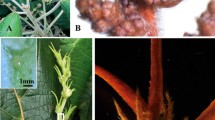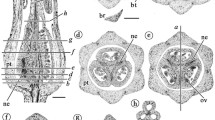Abstract
Daphne gnidium is a circum-Mediterranean evergreen shrub. Flower and pollen features related to pollination mechanism were analyzed, and the seasonal presence of insects visiting the plant was monitored. The morphology and functionality of flowers are compatible with entomophily, as are pollen viability, which is maintained for a few hours only after anthesis, and the very short stigmatic receptivity. The reproductive fitness of the species is low and the ripening process often fails (35% collapsed embryos). While male organ functionality is fairly regular, the female organ often shows developmental arrest. The complex or transient evolutionary traits displayed by D. gnidium are comparable to those of Thymelaea hirsuta and other members of the Thymelaeaceae.



Similar content being viewed by others
References
Alonso C (2005) Pollination success across an elevation and sex ratio gradient in gynodioecious Daphne laureola. Amer J Bot 92:1264–1269
APAT (1961–1990) Annali idrologici. http://www.annali.apat.gov.it
Bayers JBP, Marais E (1998) Palynological studies of the Thymelaeaceae of Cape Flora. Grana 37:193–202
Bredenkamp CL, Van Wyk AE (1996) Palynology of the genus Passerina (Thymelaeaceae): relationships form and functions. Grana 35:335–346
Brewbaker JL (1967) The distribution and phylogenetic significance of binucleate and trinucleate pollen grains in the angiosperms. Amer J Bot 54:1069–1083
Brewbaker JL, Kwack BH (1963) The essential role of calcium ion in pollen germination and pollen tube growth. Amer J Bot 50:859–865
Candau P (1987) Thymelaeaceae. In: Valdes B, Diez MJ, Fernandez I (eds) Atlas polinico de Andalucia occidental. Instituto de Desarrollo Regional n. 43, Universidad de Sevilla, EXCMA, Diputacion de Cadiz
Caporali E, Roccotiello E, Cornara L, Casazza G, Minuto L (2006) An anatomical study of floral variation in Thymelaea hirsuta (L.) Endl. related to sexual dimorphism. Plant Biosyst 140:123–131
Chaudhury AM, Koultnow A, Payne T, Luo M, Tucker MR, Dennis ES, Peacock WJ (2001) Control of early seed development. Ann Rev Cell Dev Biol 17:677–699
Cody ML, Mooney HA (1978) Convergence versus nonconvergence in Mediterranean climate ecosystems. Ann Rev Ecol System 9:265–321
Coleman AW, Goff LJ (1985) Applications of fluorochromes to pollen biology. I. Mithramycin and 49, 6-diamidino-2- phenylindole (DAPI) as vital stains and for quantitation of nuclear DNA. Stain Technol 60:145–154
Cornara L, Borghesi B, Caporali E, Casazza G, Roccotiello E, Troiano G, Minuto L (2005) Floral features and reproductive ecology in Thymelaea hirsuta (L.) Endl. Plant Syst Evol 250:157–172
Cowling RM (2002) Heterogeneity, speciation/extinction history and climate: explaining regional plant diversity patterns in the Cape Floristic Region. Divers Distrib 8:163–179
Crane PR (1986) Form and function in wind-dispersed pollen. In: Blackmore S, Ferguson IK (eds) Pollen and spores: form and function. Academic Press, London, pp 179–202
Culley TM, Weller SG, Sakai AK (2002) The evolution of wind pollination in angiosperms. Trends Ecol Evol 17:361–369
Dafni A (1992) Pollination ecology. Oxford University Press, Oxford
De la Bandera MC, Traveset A (2006) Breeding system and spatial variation in the pollination biology of the heterocarpic Thymelaea velutina (Thymelaeaceae). Plant Syst Evol 257:9–23
Dommée B, Biascamano A, Denelle N, Bompar JL, Thompson JD (1995) Sexual tetramorphism in Thymelaea hirsuta (Thymelaeaceae): morph ratios in open-pollinated progeny. Amer J Bot 82:734–740
Franchi GG, Bellani L, Nepi M, Pacini E (1996) Types of carbohydrate reserves in pollen: localization, systematic distribution and ecophysiological significance. Flora 191:143–159
Franchi GG, Nepi M, Dafni A, Pacini E (2002) Partially hydrated pollen: taxonomic distribution, ecological and evolutionary significance. Plant Syst Evol 234:211–227
Gritti ES, Smith B, Sykes MT (2006) Vulnerability of Mediterranean Basin ecosystems to climate change and invasion by exotic plant species. J Biogeogr 33:145–157
Guitián J, Guitián P (1990) Fenología de la floración y fructificación en plantas de un espinal del Bierzo (León, noroeste de España). Anales Jará Bot Madrid 48:53–61
Herber BE (2002) Pollen morphology of the Thymelaeaceae in relation to its taxonomy. Plant Syst Evol 232:107–121
Herrera CM (1981) Are tropical fruits more rewarding to dispersers than temperate ones? Am Nat 118:896–907
Herrera CM (1984) A study of avian frugivores, bird-dispersed plants, and their interaction in Mediterranean scrublands. Ecol Monogr 54:1–23
Herrera J (1985) Néctar secretion pattems in southern Spanish Mediterranean shrublands. Israel J Bot 34:47–58
Herrera CM (1986) Vertebrate-dispersed plants: Why they don’t behave the way they should. In: Estrada A, Fleming TH (eds) Frugivores and seed dispersal. Junk, Dordrecht, pp 5–18
Herrera J (1987a) Biología reproductiva de algunas especies del matorral de Doñana. Anales Jará Bot Madrid 44:483–497
Herrera J (1987b) Flower and fruit biology in Southern Spanish Mediterranean shrublands. Ann Missouri Bot Gard 74:69–78
Herrera CM (1988) Variation in mutualisms: the spatio-temporal mosaic of a pollinator assemblage. Biol J Linn Soc 35:95–125
Herrera CM, Jordano P, Guitián J, Traveset A (1998) Annual variability in seed production by woody plants and the mating concept: reassessment of principles and relationship to pollination and seed dispersal. Am Nat 152:576–594
Heslop-Harrison Y, Shivanna KR (1977) The receptive surface of the angiosperm stigma. Ann Bot 41:1233–1258
Hoekstra FA (1986) Water content in relation to stress in pollen. In: Leopold AC (ed) Membranes, metabolism and dry organism. Comstock Publishing Associates, Cornell University Press, Ithaca, pp 102–122
Jordano P (1982) Seed weight variation and differential avian dispersal in blackberries Rubus ulmifolius. Oikos 43(2):149–153
Jordano P (1987) Patterns of mutualistic interactions in pollination and seed dispersal: connectance, dependence asymmetries, and coevolution. The American Naturalist 129:657–677
Knapp AK, Burns CE, Fynn RWS, Kirkman KP, Morris CD, Smith MD (2006) Convergence and contingency in production–precipitation relationships in North American and South African C4 grasslands. Oecologia 149:456–464
Lambdon PW, Hulme PE (2006) Predicting the invasion success of Mediterranean alien plants from their introduction characteristics. Ecography 29:853–865
Minuto L, Casazza G, Profumo P (2004) Population decrease of Thymelaea hirsuta (L.) Endl. in Liguria: conservation problems for the north Tyrrhenian sea. Plant Biosyst 138(1):11–19
Minuto L, Casazza G, Profumo P (2005) Sexual polymorphism and spatial segregation of Thymelaea hirsuta in Liguria (NW Italy). Plant Biosyst 139:234–240
Moog U, Fiala B, Feerle W, Maschwitz U (2002) Thrips pollination of the dioecious ant plant Macaranga hullettii (Euphorbiaceae) in southeast Asia. Amer J Bot 89:50–59
Nepi M, Franchi GG, Pacini E (2001) Pollen hydration status at dispersal: cytophysiological features and strategies. Protoplasma 216:171–180
O’Brien TP, McCully ME (1981) The study of plant structure: principles and selected methods. Thermarcarphy, Melbourne
Pacini E (2000) From anther and pollen ripening to pollen presentation. Plant Syst Evol 222:19–43
Pickert M (1988) In vitro germination and storage of trinucleate Arabidopsis thaliana (L.) pollen grains. AIS 26. http://www.arabidopsis.org/ais/1988/picke-1988-aadeg.html
Roulston T’ai H, Buchmann SL (2000) A phylogenetic reconsideration of the pollen starch–pollination correlation. Evol Ecol Res 2:627–643
Simmons MT, Cowling RM (1996) Why is the Cape Peninsula so rich in plant species? An analysis of the independent diversity components. Biodivers Conserv 5:551–574
Smith RS, Guyomarc’h S, Mandel T, Reinhardt D, Kuhlemeier C, Prusinkiewicz P (2006) A plausible model of phyllotaxis. P Natl Acad Sci USA 103:1301–1306
Terry LI (2001) Thrips and weevils as dual, specialist pollinators of the Australian Cycad Macrozamia communis (Zamiaceae). Int J Plant Sci 162:1293–1305
Thompson JD (2005) Plant evolution in the Mediterranean. Oxford University Press, Oxford
Vagge I (1999) La diffusione del bioclima mediterraneo in Liguria (Italia Nord Occidentale). Fitosociologia 36:95–109
Venkateswarlu J (1945) Embryological studies in the Thymelaeaceae. I. Thymelaea arvensis Lamk. J Indian Bot Soc 24:45–66
Venkateswarlu J (1947) Embryological studies in the Thymelaeaceae. II. Daphne cannabina Wall. and Wikstroemia canescens Meissn. J Indian Bot Soc 26:13–39
Whelan RJ, Goldingay RL (1989) Factors affecting fruit-set in Telopea speciosissima (Proteaceae): the importance of pollen limitation. J Ecol 77:1123–1134
Acknowledgments
We are grateful to B. Borghesi and G. Troiano (DIP.TE.RIS., University of Genoa) for the identification of insects.
Author information
Authors and Affiliations
Corresponding author
Rights and permissions
About this article
Cite this article
Roccotiello, E., Casazza, G., Galli, L. et al. The flower biology of Daphne gnidium L. (Thymelaeaceae). Plant Syst Evol 279, 41–49 (2009). https://doi.org/10.1007/s00606-009-0144-1
Received:
Accepted:
Published:
Issue Date:
DOI: https://doi.org/10.1007/s00606-009-0144-1




